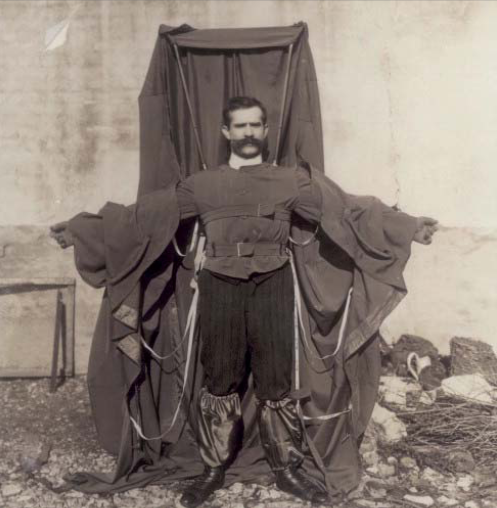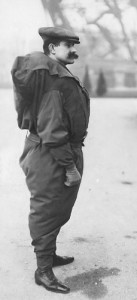
“I am confident of success.”
Franz Reichelt was sure he was right. A tailor taken with aviation, Reichelt convinced himself in 1912 that his nouveau parachute would serve and protect. French authorities forbade his planned demonstration of the contraption with a leap from the Eiffel Tower unless a dummy was used in his stead. But Reichelt would not listen to reason: He became his own dummy. These two classic photos show him just prior to his fatal miscalculation played itself out in front of hundreds. From “Dies in Parachute From Eiffel Tower,” a New York Times article that misspells the surname of the man in decline:
“Paris–Franz Reichalt, an Austrian tailor, who had been experimenting with a new form of parachute, jumped to-day from the first platform of the Eiffel Tower, 180 feet high, and fell to the ground like a stone. He was killed instantly.
Reichalt had long been interested in aviation questions. Every spare hour he spent pursuing this hobby. He recently decided to compete for a prize offered for the best form of parachute or other device which would safeguard an aviator in the event of an accident happening to his machine.
Reichalt tried several designs for a parachute and experimented with them in the courtyard of the house he occupied. Apparently his experiments to some extent were successful. At all events for weeks past Reichalt had been petitioning the authorities to allow him to make a serious trial of as apparatus from the Eiffel Tower.
Such permissions were not easily obtained, and that which he finally got from the Prefecture stipulated that the test be made with a dummy. There was little secrecy about the fact, however, that Reichalt intended to substitute himself for the dummy in spite of 10 degrees of frost and a stiff northeaster.
Several hundred people gathered underneath the Eiffel Tower toward 8 o’clock when the experiment was to be made. Reichalt arrived with a friend carrying his parachute, which was made of khaki colored canvas, weighing about 20 pounds and had a surface of nearly 40 square yards.
 Several aviation specialists were present, among them M. Hervieu, who made several experiments with the same kind of device himself, and it is significant that M. Hervieu, on examining Reichalt’s apparatus, expressed great doubt as to its practicability, advancing one or two technical arguments against it which Reichalt was quite unable to oppose.
Several aviation specialists were present, among them M. Hervieu, who made several experiments with the same kind of device himself, and it is significant that M. Hervieu, on examining Reichalt’s apparatus, expressed great doubt as to its practicability, advancing one or two technical arguments against it which Reichalt was quite unable to oppose.
But he was not shaken in his conviction even at the eleventh hour, for he said almost jauntily: ‘I am confident of success.’ Mr. Hervieu emphatically declared, on seeing a preliminary test from a distance that the parachute required much too long a time to open itself out. His judgement had hardly been made when it was most fully confirmed.
Reichelt clambered over the hand rail and threw himself forward, but the parachute never opened, and his descent was one of unbroken acceleration 180 feet to the ground. His body was a shapeless mass when the police picked it up and carried it with all speed in a taxicab to the nearest infirmary.
The accident caused a protest to be raised this evening against a repetition of such experiments except with the fullest approval and knowledge of specialists.“•
Tags: Franz Reichelt, M. Hervieu
